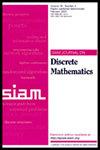数学]类偏置排列的快速混合
IF 0.9
3区 数学
Q2 MATHEMATICS
引用次数: 0
摘要
SIAM 离散数学杂志》,第 38 卷第 1 期,第 702-725 页,2024 年 3 月。 摘要在本文中,我们研究了最近邻换位马尔可夫链在排列集合上的偏置版本,其中相邻元素[math]和[math]以概率[math]按顺序[math]排列。我们的目标是找出该马尔可夫链快速混合的参数集 [math] 类别。具体来说,我们考虑了吉姆-菲尔(Jim Fill)的公开猜想[《差距问题背景》(2003)和《有趣的谱差距问题》(2003)],即所有单调、正偏分布都是快速混合的。对于[math]类粒子过程产生的分布,我们以肯定的态度解决了菲尔的猜想,在[math]类粒子过程中,元素被划分为[math]类,相邻元素交换的概率取决于元素所处的特定类。我们进一步要求[math]是一个常数,不同类别元素之间的所有概率都远离[math]。这些粒子过程是在自组织列表的背景下产生的,我们的结果也超越了排列,适用于一类中所有粒子都无法区分的情况。我们的工作概括了 Haddadan 和 Winkler [Mixing of permutations by biased transposition (2017)]最近研究 3 类粒子过程的工作。此外,我们还证明了基于树的一类更广泛的分布也是快速混合的,这也概括了 Bhakta 等人【自组织列表和偏置排列的马尔可夫链的混合时间(2013 年)】所分析的一类分布。我们的证明涉及对广义偏置排除过程的分析,该过程是应用于双粒子系统的近邻转置链。偏置排除过程具有独立的意义,可应用于自组装。我们推广了格林伯格等人(Greenberg et al. [Sampling biased lattice configurations using exponential metrics (2009)])和本杰明尼等人(Benjamini et al. [Mixing times of the biased card shuffling and the asymmetric exclusion process (2005)])关于偏置排除过程的研究成果,只要最小偏置离 1 有界,就允许交换相邻元素的概率取决于整个系统。本文章由计算机程序翻译,如有差异,请以英文原文为准。
Rapid Mixing of [math]-Class Biased Permutations
SIAM Journal on Discrete Mathematics, Volume 38, Issue 1, Page 702-725, March 2024.
Abstract. In this paper, we study a biased version of the nearest-neighbor transposition Markov chain on the set of permutations where neighboring elements [math] and [math] are placed in order [math] with probability [math]. Our goal is to identify the class of parameter sets [math] for which this Markov chain is rapidly mixing. Specifically, we consider the open conjecture of Jim Fill [Background on the Gap Problem (2003) and An Interesting Spectral Gap Problem (2003)] that all monotone, positively biased distributions are rapidly mixing. We resolve Fill’s conjecture in the affirmative for distributions arising from [math]-class particle processes, where the elements are divided into [math] classes and the probability of exchanging neighboring elements depends on the particular classes the elements are in. We further require that [math] is a constant and that all probabilities between elements in different classes are bounded away from [math]. These particle processes arise in the context of self-organizing lists, and our result also applies beyond permutations to the setting where all particles in a class are indistinguishable. Our work generalizes recent work by Haddadan and Winkler [Mixing of permutations by biased transposition (2017)] studying 3-class particle processes. Additionally, we show that a broader class of distributions based on trees is also rapidly mixing, which generalizes a class analyzed by Bhakta et al. [Mixing times of Markov chains for self-organizing lists and biased permutations (2013)]. Our proof involves analyzing a generalized biased exclusion process, which is a nearest-neighbor transposition chain applied to a 2-particle system. Biased exclusion processes are of independent interest, with applications in self-assembly. We generalize the results of Greenberg et al. [Sampling biased lattice configurations using exponential metrics (2009)] and Benjamini et al. [Mixing times of the biased card shuffling and the asymmetric exclusion process (2005)] on biased exclusion processes to allow the probability of swapping neighboring elements to depend on the entire system, as long as the minimum bias is bounded away from 1.
Abstract. In this paper, we study a biased version of the nearest-neighbor transposition Markov chain on the set of permutations where neighboring elements [math] and [math] are placed in order [math] with probability [math]. Our goal is to identify the class of parameter sets [math] for which this Markov chain is rapidly mixing. Specifically, we consider the open conjecture of Jim Fill [Background on the Gap Problem (2003) and An Interesting Spectral Gap Problem (2003)] that all monotone, positively biased distributions are rapidly mixing. We resolve Fill’s conjecture in the affirmative for distributions arising from [math]-class particle processes, where the elements are divided into [math] classes and the probability of exchanging neighboring elements depends on the particular classes the elements are in. We further require that [math] is a constant and that all probabilities between elements in different classes are bounded away from [math]. These particle processes arise in the context of self-organizing lists, and our result also applies beyond permutations to the setting where all particles in a class are indistinguishable. Our work generalizes recent work by Haddadan and Winkler [Mixing of permutations by biased transposition (2017)] studying 3-class particle processes. Additionally, we show that a broader class of distributions based on trees is also rapidly mixing, which generalizes a class analyzed by Bhakta et al. [Mixing times of Markov chains for self-organizing lists and biased permutations (2013)]. Our proof involves analyzing a generalized biased exclusion process, which is a nearest-neighbor transposition chain applied to a 2-particle system. Biased exclusion processes are of independent interest, with applications in self-assembly. We generalize the results of Greenberg et al. [Sampling biased lattice configurations using exponential metrics (2009)] and Benjamini et al. [Mixing times of the biased card shuffling and the asymmetric exclusion process (2005)] on biased exclusion processes to allow the probability of swapping neighboring elements to depend on the entire system, as long as the minimum bias is bounded away from 1.
求助全文
通过发布文献求助,成功后即可免费获取论文全文。
去求助
来源期刊
CiteScore
1.90
自引率
0.00%
发文量
124
审稿时长
4-8 weeks
期刊介绍:
SIAM Journal on Discrete Mathematics (SIDMA) publishes research papers of exceptional quality in pure and applied discrete mathematics, broadly interpreted. The journal''s focus is primarily theoretical rather than empirical, but the editors welcome papers that evolve from or have potential application to real-world problems. Submissions must be clearly written and make a significant contribution.
Topics include but are not limited to:
properties of and extremal problems for discrete structures
combinatorial optimization, including approximation algorithms
algebraic and enumerative combinatorics
coding and information theory
additive, analytic combinatorics and number theory
combinatorial matrix theory and spectral graph theory
design and analysis of algorithms for discrete structures
discrete problems in computational complexity
discrete and computational geometry
discrete methods in computational biology, and bioinformatics
probabilistic methods and randomized algorithms.

 求助内容:
求助内容: 应助结果提醒方式:
应助结果提醒方式:


